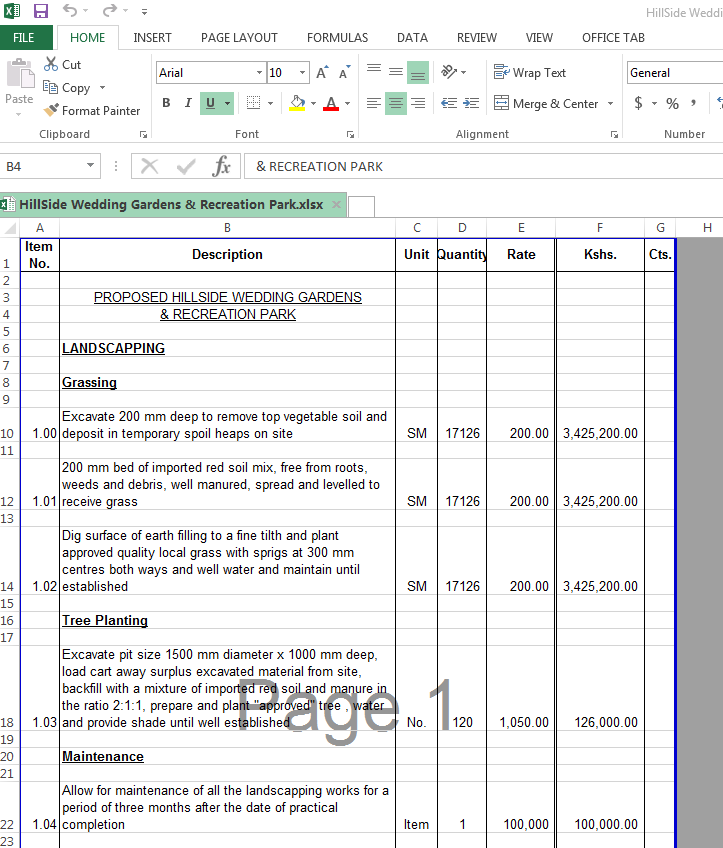A Bill of Quantities, as defined by the Business Dictionary, is an itemized list of materials, parts and labour with their costs, required to undertake construction work.
It can also be defined as a document compiled for construction projects in which all elements of material, labour, profits and contractors overheads, plant and equipment needed to construct are itemized and described in detail, quantified and priced according to an adopted standard method of measurement.
This document is prepared by a person known as a Quantity Surveyor (or QS in short form). The QS is a person who has undergone education and training in an accredited university/college and professional training by the licensing body operating in the host country. To prepare a BoQ (short form of Bills of Quantities) the QS examines drawings from the architect and the engineer and prepares a list of work items which he then describes in detail and allocates a cost to it. The result is a document that looks like the one in the image below:

Types of Bills of Quantities
According to Designing Buildings Wiki, there are two distinguishable types of bills of quantities. These are Firm Bill of Quantities and Approximate Bill of Quantities.
A firm bill of quantities is the one where the work is measured and described precisely which enables those pricing it (the tenderers) to price it with precision. In contrast to that, an approximate bill of quantities involves measurement and description of quantities that are notional or provisional. This is because it is mostly prepared in the case where the project has reached the tendering stage but the amount of design information available is not enough to enable the QS to prepare a precise description and quantification of the works.
The use of a Bill of Quantities
- It provides the quantities of work to be executed when the contract is entered into.
- Defines the quality of workmanship and materials to be used as specified in the specifications section
- It provides its users with an estimated cost of the project they are dealing with
Carrey, A (CEO of Measure Manage Company Perth, a professional Quantity Surveying Firm) summarises the above uses of a BoQ into two main uses. His argument is that during the preconstruction stage, the BoQ is used to provide the same information to all the tendering contractors to facilitate them to prepare accurate tenders in an efficient way to allow for comparisons during the technical evaluation stage.
During the construction stage, a bill of quantities is used to provide a basis for the valuation of the completed works for the purposes of making periodic payments (called interim payments) to the contractor who has been awarded the contract and proceeded with its execution.
It is essential that the Quantity Surveyor prepares a detailed and accurate Bill of Quantities as it has the following benefits:
- It saves times during the tendering stage where all contractors use one document to prepare their bids as opposed to where they might be required to each prepare their own BoQs.
- Where one unpriced BoQ is used to obtain bids from prospective contractors, it is easier for the tendering committee to do an evaluation and choose the most suitable contractor as the process of evaluation is based on one common document.
- It assists in budgetary and cost control during the construction phase, through interim valuations and valuation of variations.
We have discussed what a bill of quantities is and its use in a construction project. It is therefore important for anyone looking into undertaking any type of construction or civil engineering project to hire a professional cost consultant/quantity surveyor to help with the estimation of costs, budgeting, construction time forecasting and cash flow forecasting. The basis of all those QS services is based on the skill of preparation of a proper, accurate bill of quantities with detailed yet precise descriptions.
Join me on Patreon! https://t.co/RjNcQjo2C2
— QuantBuild Academy (@quantbuild_KE) July 27, 2020


Hello sir I’m a QS student of NDU.
Can I have your WhatsApp number pls??
Hi Alex. Am glad to connect with you here. You can easily message me on WhatsApp using this link https://wa.me/message/CL43Y2LRSGNXN1